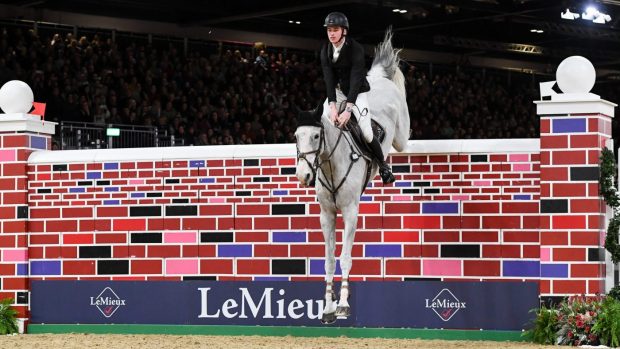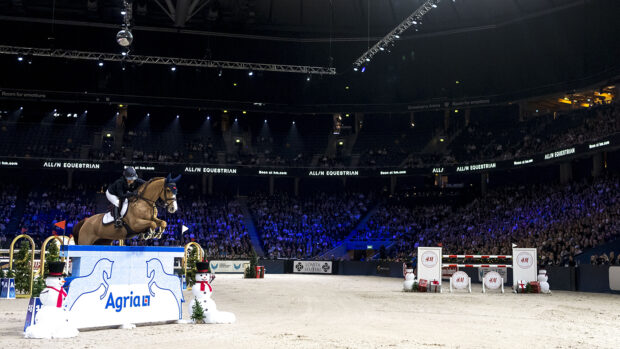The appetite among eventing’s leaders to reopen the flag rule debate has gone from “hell no” to “yes please” after a potential breakthrough in Sweden.
Eventing’s flag rules are a spiky subject, concerning the grey area where a combination knocks a flag on a cross-country fence. This results in sometimes lengthy decisions as to whether they were clear (no penalties), ran out (20 penalties), or the horse’s point of shoulder was outside the extremities of the obstacle, but its hindquarters jumped the height of the solid part (15 penalties).
By its nature, the flag rule usually comes into play at narrow or corner fences and has had many variations in definition and penalties over the years.
Vet and FEI risk management steering group member Staffan Lidbeck presented the rule, which has been in place in national competition in Sweden since 2020, at the FEI eventing risk management forum.
Flags are attached to fences using rubber bands and metal cramps, and the upper attachment can be dislodged. Mr Lidbeck stressed that it is not crucial for flags to be attached in exactly the same way from fixture to fixture, but the way fences are flagged must be consistent for everyone competing at that event.
Combinations automatically receive seven penalties when a flag loses its upper attachment, and 20 penalties for a run-out or when a horse jumps the fence with no part of his hindquarters going through the flag.
“We have to make the cross-country more influential. There are too many clear rounds and this is a safe way to make the cross-country test more influential,” he said, adding that this is perhaps not the final answer, but it is working in Sweden. “It will also enhance more precise and balanced riding and thus improve safety. It will make life easier for officials and also for riders.”
He said the Swedish federation decided on seven penalties as it means combinations can have two flags and still finish with a qualifying score, but not three.
But it has not been tested at higher levels, as all fixtures at three-star (intermediate) and above in Sweden are FEI events.
Swedish eventing technical delegate and course-designer Lars Christensson said: “I think it has made riders respect fences more, and they ride more correctly. We will be going the right way if we introduce this in the sport.”
Rider Clayton Fredericks said: “I think yes, there is a place for this. I would agree that the penalties should be low. It’s clear and concise. There’s probably still going to be some discussion if it’s a marginal slide-off. We want everyone to be aiming for that perfect ride, we know no one ever gets that, but that’s the goal.”
Cleonice Attolico Guglielmi said that as a ground jury member, she “really likes this rule”.
“I think it’s going to make riders ride more accurately. It’s going to make them ride combinations safely,” she said.
Eventing Riders Association president Bruce Haskell said: “The question we really have to ask before we make any changes is what is wrong with the current rule and what is the perceived need to change?”
He added that everyone wants a sport that makes quick decisions – having a debate hours after a rider’s round at an Olympics as to whether they had penalties or not is “unacceptable” – and any changes have to be balanced decisions.
Course-designer and technical delegate Alec Lochore questioned whether there would be a risk it may push riders further towards the wider part of corners.
Course-designer Mike Etherington-Smith said he personally does not like the idea, but understands the logic and that anything that can get results out more quickly at the end of the day is important.
He read out notes from a discussion before Christmas with top riders, coaches and course-designers about this and said: “It’s not going to necessarily reduce some of the discussions that ground juries have to have at the end of the day, about whether something was a run-out or not.
“It’s not going to be one cure to fix all these things. But hopefully some of the discussions will be taken off the table.”
FEI eventing committee chairman David O’Connor asked the forum if a group should be put together to propose this rule in near future, and was met with a strong show of hands from the room.
“That is a shift, because four years ago that was ‘no and hell no’,” he said. “There’s a shift in thinking of the direction the sport is going, and that’s why we are here.”
- What do you think about the eventing flag rule debate? Send your thoughts to hhletters@futurenet.com, including your name, nearest town and country, for consideration for the Horse & Hound letters pages
You might also be interested in:

Subscribe to Horse & Hound magazine today – and enjoy unlimited website access all year round

Calls for change to ensure all riders at five-star are ready for the challenge

Holding riders responsible for horse falls and removing fences – ideas to make eventing safer
Horse & Hound magazine, out every Thursday, is packed with all the latest news and reports, as well as interviews, specials, nostalgia, vet and training advice. Find how you can enjoy the magazine delivered to your door every week, plus options to upgrade your subscription to access our online service that brings you breaking news and reports as well as other benefits.




